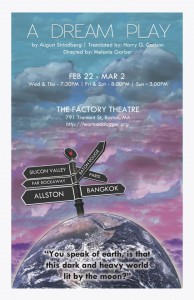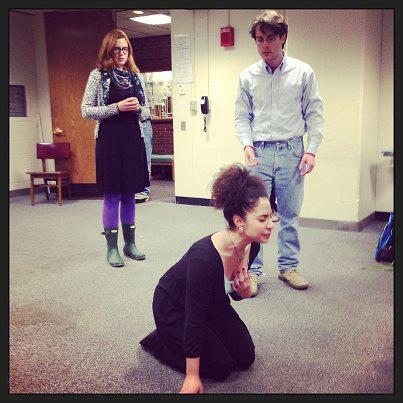A Dream Play
Presented by Heart & Dagger Productions
By August Strindberg, Translated by Harry G. Carlson
Directed by Melanie Garber
791 Tremont Street, Boston
Directing Profile by Becca Kidwell
Melanie Garber has a dancer’s sensibility of direction with Heart & Dagger Productions’ A Dream Play, but this is not a surprise. She has shown this intricate direction in Actor’s Shakespeare Project’s Medea, Fresh Ink Theatre Company’s Priscilla Dreams The Answer, and Heart & Dagger’s Crave. Not only does Ms. Garber make words come alive, but she also brings life to words. From the initial moments of each of the productions, she chooses specific, distinct movements that create the environment of the play.
With A Dream Play, music and indistinct voices establish the magical atmosphere for Agnes, Indra’s daughter played by Lauren Foster, to contrast with the gritty reality of Agnes’ journey to the earth. Ms. Garber had used similar techniques to establish the dark, tragic tone of Medea
Garber’s direction provides seamless transitions from scene to scene, which is particularly vital for plays like A Dream Play and Priscilla Dreams The Answer. A Dream Play‘s structure provided the turning point for modern theatre. Strindberg used the recognizable format of medieval mystery plays to travel from scene to
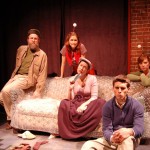
The ensemble of Priscilla Dreams the Answer. Left to Right: Bob Mussett (Harry), Dakota Shepard (Zop), Caroline L. Price (Priscilla), Michael Caminiti (Simon), Emily Kaye Lazzaro (Zip). Photo Credit: Sarah E. Farbo
scene, but twists it to examine not only religion, but also philosophy, science, legislation, and life as a dream. Without a focused pattern of movement, A Dream Play could seem like a disjointed, abstract piece of hubris. Garber makes deliberate choices that provide a flow from scene to scene as if the entire play was a dance. As Agnes moves from location to location, from castle to a country house an opera house the few set pieces (a table and a few chairs) are transported from one stage area to another without missing a beat of the action or language of the play. Similarly, the whirlwind of Priscilla’s adventure in Priscilla Dreams The Answer went from reality to fantasy to postulations without any obvious breaks in narrative.
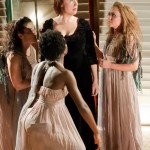
Medea with Chorus, L to R: Sarah Newhouse*, Obehi Janice, Jennie Israel* & McCaela Donovan © 2012 Stratton McCrady Photography
Part of the dance is intricate, yet subtle secondary stage business. One of the blessings (and curses) of public domain works are the lack of written stage directions within the script. While this leaves more room for interpretation, it also can leave a production with a lack of substance and depth “full of sound and fury, signifying nothing.” This is where Melanie Garber’s expertise flourishes. In A Dream Play, Garber has other characters do “stage business” that both emphasizes the main scene and provides contrast and noise to make the scene richer. The students grasping for their iPhones during clasp adds an additional reality to the scene in the schoolhouse. Another choice that added to the words of a scene happened during the argument between the “right-thinking people,” is the physicality of the argument. While the words could have a minuscule philosophical impact by themselves, the characters embody these arguments physically, which seems like a natural and obvious choice; however, this direction was not likely in the printed script and this is where Garber’s excellence shines.
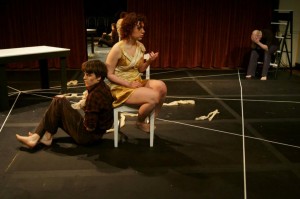
Abigail Matzeder, Michael Underhill, and Terrence Patrick Haddad in CRAVE — at Calderwood Pavilion, Photo Credit: Heart and Dagger Productions
Like a keen magician, she makes something that is staged seem so effortless and spontaneous. I have witnessed this with all of the productions that Melanie Garber has directed and I continue to look forward to seeing productions that has been directed by her.
